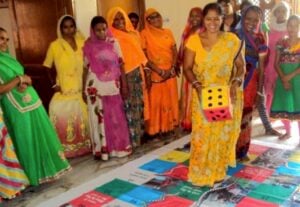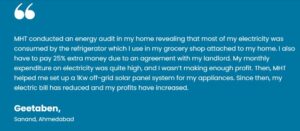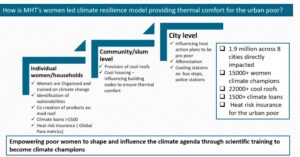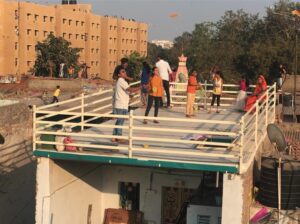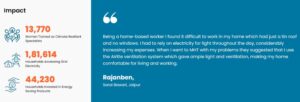Mahila Housing Trust
As the earth warms, an estimated 190 million people who live in slum households in south Asia are among the most susceptible to climate harms, as their informalised settlements are out of the ambit of public service provision. Slum residents are also more vulnerable to warming because their houses are built with heat-trapping materials such as tin sheets, cement sheets (asbestos), plastics and tarpaulin, and without proper ventilation.
A study finds that slums in Mumbai city are 6°C warmer than neighbouring housing societies. These are also the workplace conditions for most slum residents, who engage in home-based work. Therefore, the Mahila Housing Trust (MHT), an India-based non-profit, aims to organise and empower women living in impoverished communities to improve their working and living conditions.
MHT believes that offering grassroots collectives of women the knowledge, technology and skills to identify and assess development issues enables them to constructively engage with governments and planning processes so as to lead change in their own communities. MHT demystifies climate warming for people living in impoverished communities by targeted training initiatives and localised communication strategies.
These focus on five key effects of warming: heat waves, flooding, water scarcity, vector disease, and air pollution. Methods such as games, one-on-one meetings and wall paintings are used to generate interest in the concept of climate warming and its impacts and to build climate resilience. For instance, snakes and ladders is used to explain the science behind climate change and the unbearable summers and monsoons to women.
Women in urban slums learning about climate change by playing snakes and ladders
Through a multi-step leadership development model, local women leaders are identified to lead climate action, and are trained to collaborate and eventually work independently with governments and service providers. Adaptation solutions are locally led by Community Based Organisations and Community Action Groups, facilitated by MHT across thousands of informal settlements. A socio-technical approach bridges the gap between research and action by sharing insights into ‘what the community wants’ with relevant experts and governments, facilitating innovations that can meet the twin needs of informal communities: aspiration and affordability.
MHT has also forged partnerships with electricity companies to simplify access to legalised electric connections in slum settlements and support a clean energy transition with grassroots-level actions. A network of women energy auditors encourages families to make climate resilient investments and adopt solutions that are affordable and practicable, such as cool roofs, LED lighting, alarms/alerts for heatwaves, smokeless cooking stoves, and solar lighting and cooling systems.
Cool roofs, co-created with the communities, are a highly effective and popular solution for extreme heat. A range of options, from cost effective paints to more sophisticated and aspirational modular roofs, ensure financial affordability while catering to different needs. For instance, solar reflective white paint reduces heat absorption, while resin-coated bamboo mats form lightweight, weather-resistant panels. With inputs from MHT, cool roofs have also been incorporated into the city of Ahmedabad heat action plan and developed into a citywide cool roof program prioritising the settlements made most vulnerable.
Cool roofs lower indoor temperatures by 2 to 5°C and are a cost-effective solution covering 2% of Ahmedabad’s lowered-income households. As part of MHT’s project to solarise fans, lights, and sewing machines for work, women have installed solar panels reducing their average monthly bills by as much as half. Each dollar spent by MHT has resulted in leveraging government investment and community contributions of $22 and creating assets worth $90.[1]
More information can be found here.
Woman painting a roof with solar reflective white paint
Over the last 27 years, MHT has made significant improvements in the lives of the urban poor living in 1,034 slum settlements and has co-created 983 Community Action Groups each with 10-15 members who are grassroots women leaders in their communities. MHT thus possesses a strong social capital of 15,238 grassroots leaders who serve as amplifiers in impoverished urban communities. Finally, MHT has contributed to citywide policies and built bridges between people living in slum communities and the municipal and state governments. The policy improvements have been actualised in heat action plans and an energy conservation building code for public housing.
A modular type of cool roof
Climate warming is known to exacerbate gender inequalities as women have less access to resources for climate adaptation and face more difficulty recovering from the effects of ecological disasters as they are more likely to be employed in small enterprises in the informal economy. When policy makers recognise this, however, they build a narrative of women as victims, overlooking their contributions and limiting their agency to create change.
Therefore, MHT’s initiatives aim for an alternative, innovative and powerful narrative of women as change agents who are confident climate advocates and leaders with a say in government policy. The women-led structure empowers them at the multiscale levels of household, community, and city. Their shaping of urban development agendas is demonstrated in a Jodhpur project where MHT pioneered a roadmap for women-led Community Based Organisations to steer the city’s agenda on climate change by co-creating its heat action plan.
MHT works with women informal economy workers to improve their earning capacity and comfort as they work. It has enabled solar energy adoption or related changes amongst 1.2 million urban poor, resulting in household savings of $40 million each year. It has created a network of over 250 women entrepreneurs and trained over 15,000 climate champions who are empowered to work with stakeholders to co-create solutions for climate challenges faced by people living in urban slums.
Initiatives in participatory government, such as the successful incorporation of climate resilience measures in the Ahmedabad Heat Action Plan 2018 and the drafting of the 2019 Cool Roof Policy have yielded significant improvements in the livelihoods of slum residents in terms of access to affordable, reliable fuel and legal electricity at lower tariffs, sufficient lighting for work, increased productivity and incomes, a safe and conducive study environment, and smokeless cooking fuel. The effects are longer lasting as 2 million people are made aware of the concepts of renewable energy and energy efficiency, and the benefits of using energy efficient appliances in workplaces and homes.
MHT’s climate change program aims to build resilience in urban poor communities in south Asia against the five climate risks mentioned above. It currently operates in nine states (Gujarat, Rajasthan, Jharkhand, Delhi, Karnataka, Uttar Pradesh, Maharashtra, Madhya Pradesh and Odisha) and also in Bangladesh and Nepal, by partnering with local organisations. It aims to scale its women-led model of climate resilience across south Asia to benefit the 190 million people living in informal urban settlements. It plans to solarise micro, small and medium enterprises and the houses of 49 million home-based workers in India. To ensure inclusion and responsiveness to the needs of the most vulnerable, MHT continues its advocacy with smaller cities on developing and implementing climate action plans, including natural solutions.
To scale operations will require institutional funding support for increased investment to create, revive and strengthen the Community Action Group networks across program cities, to build organisational capabilities, and to set appropriate systems. Another critical factor will be to leverage digital technology and geospatial data from the grassroots to automate processes for more efficient data collection and analysis. Using remote sensing data and artificial intelligence will enable better decisions by the MHT team and its partners, including governments.
[1] The estimate refers to investments in climate resilience made by governments or communities that also result in building a household asset, largely a housing improvement, such as a cool roof.

















